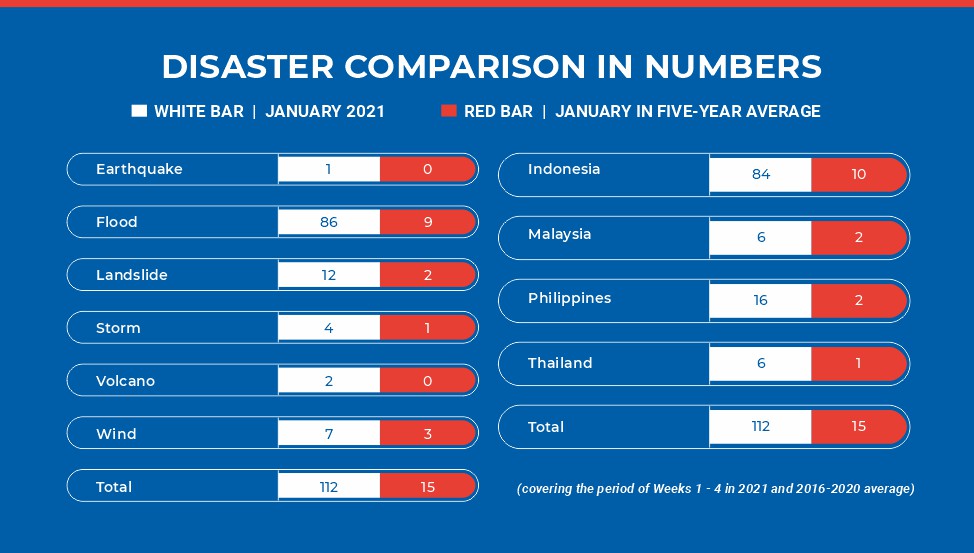
MONTHLY DISASTER REVIEW AND OUTLOOK
JANUARY 2021 | DISASTER MONITORING & ANALYSIS
(DMA) UNIT, AHA CENTRE
GENERAL REVIEW OF JANUARY 2021
The figures of recorded disasters for the first month of 2021 were significantly higher than the five-year average for the same period. The region reported around a seven-fold increase in the overall number of disaster occurrences. Despite this large difference in disaster numbers, the number of affected and displaced persons for January 2021 were only around 1.5 times higher. On another note, significantly higher number of damaged houses, casualties, injuries, and number of missing persons were observed compared to January averages. The staggering impact on ASEAN populations was largely driven by the M6.2 earthquake in West Sulawesi during the second week of January. Close to 100,000 individuals were affected and displaced by this event, which also claimed over 100 lives. Outside of this earthquake, almost 80% of recorded disasters were floods, which can be attributed to the Northeast Monsoon conditions. This is characterised by wetter conditions in the southern ASEAN region, particularly Indonesia where 70 of the 86 flood disasters were recorded. These figures also do not yet include other hydro-meteorological disasters – such as storms and rain-induced landslides – which have also been reported during January 2021.
A total of 29 significant earthquakes (M≥5.0) were reported in the region for January 2021. As previously mentioned, the M6.2 earthquake in West Sulawesi on 15 January resulted in significant loss and impact to local populations and infrastructure. Volcanic activity was reported for Alert Level III volcanoes in Indonesia, with Mount Merapi, Sinabung, Semeru, and Karangetang under close monitoring. Recent volcanic activity was also reported for the mountains of Ibu, Dukono, and Raung in Indonesia (Alert Level II), and Mayon in the Philippines (Alert Level I), but there were no reports of significant damage.
SEASONAL OUTLOOK
According to the seasonal forecast by the ASEAN Specialised Meteorological Centre (ASMC) for February to April 2021, Northeast Monsoon conditions persisted over the ASEAN region in January 2021. The northern ASEAN region continues to experience its traditional dry season as the monsoon rain band lies south of the Equator during the Northeast Monsoon. The prevailing northeasterly or easterly winds over the region could strengthen at times under the influence of high pressure systems moving eastwards over continental Asia. During February, Peninsular Malaysia and Singapore could also at times experience dry and windy conditions as they enter the dry phase of the Northeast Monsoon. Elsewhere in the southern ASEAN region, shower activities are expected with the prevailing winds blowing from the northwest or northeast. Light and variable wind conditions are expected across the ASEAN region as inter-monsoon conditions develop in March-April 2021.
For the February to April 2021 period, models predict above-average rainfall over much of the ASEAN region north of the equator. La Niña conditions are still present over the tropical Pacific Ocean, with climate models predicting La Niña conditions to last through the first quarter of 2021, but weakening during the boreal spring (March – May). La Niña conditions are typically associated with wetter-than-average conditions over the Southeast Asia region.
Warmer-than-average temperatures are expected over the eastern Maritime Continent as well as Myanmar. Much of mainland Southeast Asia, except Myanmar, may experience below-to near-normal temperatures. As the traditional dry season for the Mekong sub-region becomes firmly established during February to April 2021, dry conditions are forecast to persist despite above-average rainfall outlooks for parts of the sub-region. This is expected to cause hotspot situations in the sub-region to remain elevated, and an increased risk of transboundary haze may also be expected. In some parts of the southern ASEAN region isolated hotspots with localised smoke plumes may develop at times during periods of drier weather.
Sources : ASEAN Disaster Information Network (ADINet), ASEAN Specialised Meteorological Centre (ASMC), ASEAN Disaster Monitoring and Response System (DMRS), Badan Nasional Penanggulangan Bencana (BNPB), Pusat Vulkanologi dan Mitigasi Bencana Geologi (PVMBG), Badan Meteorologi, Klimatologi dan Geofisika (BMKG), National Disaster Risk Reduction and Management Council (NDRRMC), Philippine Institute for Volcanology and Seismology (PHIVOLCS), National Disaster Management Agency – Malaysia (NADMA), Department of Disaster Prevention and Mitigation – Thailand (DDPM), Viet Nam Disaster Management Authority (VNDMA)
Written by : Keith Paolo Landicho, Sadhu Zukhruf Janottama, Lawrence Anthony Dimailig
DISCLAIMER
Disclaimer from ASMC: The qualitative outlook is assessed for the region in general and based on the latest runs from models provided by the SEA RCC-Network LRF node. For specific updates on the national scale, the relevant ASEAN Member States’ National Meteorological and Hydrological Services should be consulted. Hydrological Services should be consulted.



